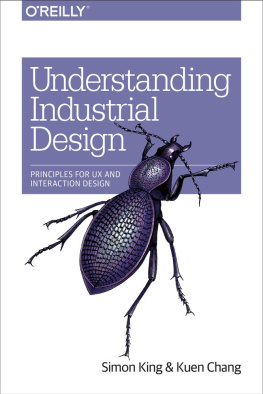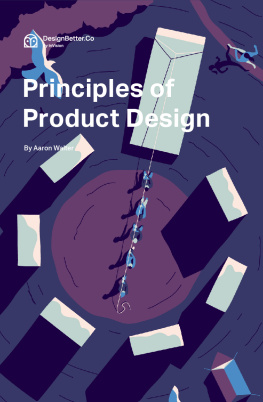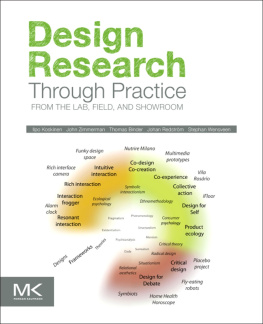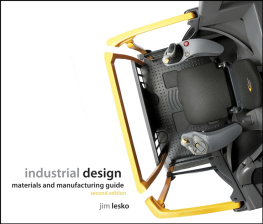Simon King and Kuen Chang - Understanding Industrial Design: Principles for UX and Interaction Design
Here you can read online Simon King and Kuen Chang - Understanding Industrial Design: Principles for UX and Interaction Design full text of the book (entire story) in english for free. Download pdf and epub, get meaning, cover and reviews about this ebook. year: 2016, publisher: O’Reilly Media, genre: Home and family. Description of the work, (preface) as well as reviews are available. Best literature library LitArk.com created for fans of good reading and offers a wide selection of genres:
Romance novel
Science fiction
Adventure
Detective
Science
History
Home and family
Prose
Art
Politics
Computer
Non-fiction
Religion
Business
Children
Humor
Choose a favorite category and find really read worthwhile books. Enjoy immersion in the world of imagination, feel the emotions of the characters or learn something new for yourself, make an fascinating discovery.
- Book:Understanding Industrial Design: Principles for UX and Interaction Design
- Author:
- Publisher:O’Reilly Media
- Genre:
- Year:2016
- Rating:5 / 5
- Favourites:Add to favourites
- Your mark:
- 100
- 1
- 2
- 3
- 4
- 5
Understanding Industrial Design: Principles for UX and Interaction Design: summary, description and annotation
We offer to read an annotation, description, summary or preface (depends on what the author of the book "Understanding Industrial Design: Principles for UX and Interaction Design" wrote himself). If you haven't found the necessary information about the book — write in the comments, we will try to find it.
Understanding Industrial Design: Principles for UX and Interaction Design — read online for free the complete book (whole text) full work
Below is the text of the book, divided by pages. System saving the place of the last page read, allows you to conveniently read the book "Understanding Industrial Design: Principles for UX and Interaction Design" online for free, without having to search again every time where you left off. Put a bookmark, and you can go to the page where you finished reading at any time.
Font size:
Interval:
Bookmark:

Beijing Boston Farnham Sebastopol Tokyo
The most difficult and interesting problems of the 21st century wont be solved by apps alone. Software might be eating the world, but its the hardware mouth doing the chewing. As the boundary between digital and physical grows ever blurrier, more UX designers will have to consider more than just a 2D screen to do their jobs. This book connects the dots between interaction and industrial design in clear, thoughtful prose with vivid examples. Even if you dont design hardware (yet), its timeless insights and principles culled from decades of physical products cant help but make your designs better. Get this book.
DAN SAFFER, AUTHOR OF MICROINTERACTIONS
Industrial design is one of the great design disciplines, and its influence on user experience design is both underestimated and misunderstood. As computing becomes more distributed and the Internet of Things becomes the dominant context for UX design, its increasingly important for all UX designers to become literate in the principles of industrial design, to incorporate it into their practice, and to understand its core ideas to work on teams with industrial designers. This book is a great and readable introduction to the intersection of ID and UX, written by designers with years of experience in both.
MIKE KUNIAVSKY, AUTHOR OF SMART THINGS
This wonderful book, full of elaborate and detailed design examples, represents an important step in the evolution of the field of interaction design. The principles within are inordinately useful. Its a must-have for the bookshelf for communication, industrial, interaction, and system designers who are practicing design today.
JODI FORLIZZI, PROFESSOR OF HUMAN-COMPUTER INTERACTION CARNEGIE MELLON UNIVERSITY
Great product design needs to consider so much more than functionality and usability; it is also about emotions, materials, pleasure, manufacturability, and sustainability, to name just a few other topics. This book is a journey through different perspectives on design that are often overlooked, but that matter so much for great products.
Especially given the IoT, where the digital and physical experiences of products become much more intertwined, Understanding Industrial Design is a must-read for any designer, developer, or entrepreneur working on a product with physical touch points.
The book plays another important role: it fosters mutual understanding and deeper collaboration of the all too often separated digital and physical design practices.
MARTIN CHARLIER, CO-AUTHOR OF DESIGNING CONNECTED PRODUCTS
An essential read for any interaction designer or UX professional who wants to understand the history, role, and responsibilities of Industrial Design.
TOM METCALFE, DESIGNER AND TUTOR
Throughout the last century, the discipline of industrial design has refined an understanding of how to design physical products for people. More recently, as computation and network connectivity extend beyond the screen, interaction designers and UX professionals also find themselves addressing design problems in the physical world. Smart products, connected devices, the Internet of Thingsthese terms address a new class of product that is both physical and digital, one that speaks to the need for design disciplines to leave their silos and find productive overlap. For designers who built their careers on the nuances of screen-based interactions, it can be disorienting to address broader UX challenges with a substantial physical component. Although the context is new, much can be learned from the long-standing history and principles of industrial design. Technology evolves rapidly, but the underlying qualities that define the products we love have not changed.
In the past, one could often draw a clean line between hardware and software. As that edge blurs, industrial and interaction designers need to combine their expertise and learn from each other. In the 1990s, the emergence of the Web led designers to develop new interaction patterns for an entirely new medium. A similar definition of best practices is needed for this era, drawing from expertise embedded across multiple disciplines to create an integrative set of practices. Intertwining physical and digital experiences into a unified and coherent whole requires designers of all types to stretch and learn. Industrial designers need new sensitivities toward complex system states, remote interactions, privacy considerations, and the open-ended potential of how input can map to output. Interaction designers need to embrace physical and spatial possibilities, consider a persons whole body, and use new forms of feedback less reliant on a screen.
The goal is not that interaction designers should all become industrial designers, or vice versa, but that these two design disciplines should find an overlap of skills and approaches appropriate to a world where the traditional distinctions between physical and virtual are increasingly blurred. Effective collaboration and professional overlap requires respect and understanding of each others disciplines. Because the UX community includes people of such richly varied backgrounds, a grounding in the field of industrial design is often lacking. This book aims to bridge that divide using tangible examples, organized into seven design principles, to illustrate processes, products, and points of view from industrial design practice. Through these case studies, interaction designers and UX professionals can find inspiration for how to approach, frame, and evaluate their work as it extends beyond the screen and into the physical world.
The primary audience for this book is interaction designers and UX professionals who find themselves in the overlap between physical and digital products, or foresee their practice involving more collaboration and integration with industrial design. It is written for the thoughtful practitioner, who wants to learn from practical examples and combine those approaches into their own point of view. We hope the reader will bring an open mind, and look for fruitful connections between disciplines while avoiding territorial definitions. The examples in this book may originate primarily from industrial design, but the reader should be prepared to view them through a broad lens of user experience.
Designers who intend to focus purely on screen-based products may find that the principles in this book still provide them with new ways to frame and approach their work. At times, examples from industrial design provide the possibility of relating a principle directly to a screen-based interaction, but translation of physical design solutions to screen-based alternatives is not a primary goal of this book.
Students studying industrial design will find a jumping-off point for further exploration of particular projects and principles, but should look to other texts for instructional or how-to approaches to their discipline.
Finally, anyone who simply wants to learn more about industrial design will also find value in the text. A basic familiarity with design professions in general is assumed, but no specific domain knowledge is expected or required of the reader.
Font size:
Interval:
Bookmark:
Similar books «Understanding Industrial Design: Principles for UX and Interaction Design»
Look at similar books to Understanding Industrial Design: Principles for UX and Interaction Design. We have selected literature similar in name and meaning in the hope of providing readers with more options to find new, interesting, not yet read works.
Discussion, reviews of the book Understanding Industrial Design: Principles for UX and Interaction Design and just readers' own opinions. Leave your comments, write what you think about the work, its meaning or the main characters. Specify what exactly you liked and what you didn't like, and why you think so.







